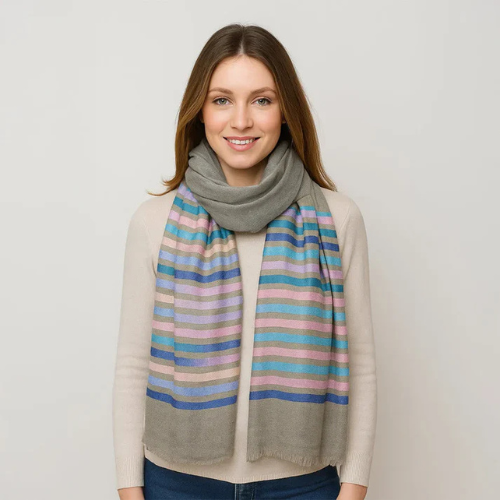The Science Behind Pashmina Wool Shawl’s Incredible Softness
Few fabrics evoke the sense of luxury, warmth, and elegance like a pashmina wool shawl. Renowned for its exceptional softness and lightweight feel, this shawl is a wardrobe staple for fashion enthusiasts around the world. But what exactly gives pashmina its unmatched comfort and texture? The answer lies in a combination of biology, traditional craftsmanship, and meticulous processing techniques. Understanding the science behind its softness allows you to appreciate this luxurious accessory even more.

Origins of Pashmina Wool
The incredible softness of pashmina starts at its source: the Himalayan mountain goats. Specifically, the undercoat of the Changthangi or Pashmina goats contains fine, ultra-soft fibers that are naturally lightweight yet insulating. These fibers are thinner than human hair—typically measuring 12 to 16 microns in diameter—which is a primary reason for their smooth, gentle texture.
The undercoat grows as a protective layer during harsh winter months and is carefully collected during the molting season. This natural origin ensures that the fibers are not only soft but also possess excellent thermal regulation, keeping the wearer warm without bulk.
Fiber Structure and Softness
The microscopic structure of pashmina fibers is a key contributor to the shawl’s luxurious feel. Pashmina fibers have a hollow, triangular cross-section that allows them to trap air efficiently, providing insulation and softness simultaneously.
- Fine Diameter: The thinner the fiber, the softer it feels against the skin. Pashmina fibers are finer than regular cashmere or wool.
- Natural Crimp: The slight crimp in the fiber adds elasticity and resilience, helping the shawl maintain its shape.
- Smooth Surface: Unlike coarse wool, pashmina fibers have a smooth cuticle layer, reducing friction against the skin and minimizing irritation. This unique fiber structure ensures that every pashmina wool shawl drapes elegantly while remaining exceptionally soft to touch.
Craftsmanship and Hand-Spinning
The soft texture of pashmina is not solely dependent on the raw fiber—it also results from careful craftsmanship. Traditionally, fibers are hand-combed and spun into fine yarns. This labor-intensive process preserves the delicate fibers, preventing breakage and maintaining their natural softness.
Hand-spinning ensures that the fibers are aligned properly, creating consistent, silky yarns that are then woven into shawls. Unlike machine processing, which can damage delicate fibers, handcrafting maintains both quality and tactile comfort.
Weaving Techniques and Finishing
The weaving and finishing processes further enhance the softness of a pashmina wool shawl. Expert weavers use intricate patterns and fine thread counts to produce lightweight, airy fabrics that feel like a second skin.
Key factors in weaving and finishing include:
- Thread Count: Higher thread counts lead to denser, smoother fabrics.
- Finishing Techniques: Shawls are washed, brushed, and lightly pressed to soften the fibers further.
- Drape and Flow: Proper weaving allows the fabric to drape fluidly, enhancing the tactile experience.
These techniques ensure that every shawl maintains its luxurious softness while providing warmth and elegance.
Benefits of Softness Beyond Comfort
While softness is a hallmark of a pashmina shawl, it also offers practical advantages.
- Thermal Comfort: The fine fibers trap heat effectively without adding bulk, making the shawl ideal for all seasons.
- Hypoallergenic Properties: Soft pashmina fibers are less likely to irritate sensitive skin compared to coarse wool.
- Versatility in Styling: The lightweight softness allows for versatile draping, knotting, or layering.
- Durability: High-quality, soft fibers are less prone to pilling and maintain their feel for years with proper care.
This combination of tactile pleasure and functional benefits makes pashmina a true investment in both style and comfort.

Caring for Your Pashmina Shawl
Maintaining the softness and longevity of a pashmina wool shawl requires careful handling. Some essential care tips include:
- Hand Wash or Dry Clean: Avoid machine washing to preserve delicate fibers.
- Gentle Detergents: Use mild, pH-neutral soaps to prevent fiber damage.
- Proper Storage: Fold and store in breathable cotton bags to avoid moisture and moths.
- Avoid Rough Surfaces: Keep the shawl away from abrasive textures that can cause snagging or pilling.
With attentive care, your shawl will retain its unparalleled softness and luxurious drape for decades.

Conclusion: Experience the Luxury of Science and Craft
A pashmina wool shawl is more than just an accessory—it’s the result of centuries of craftsmanship, biological uniqueness, and precise processing. Its incredible softness comes from ultra-fine Himalayan fibers, hand-spinning techniques, and meticulous weaving and finishing. Owning and wearing a pashmina shawl allows you to experience luxury in its purest form: warmth, comfort, and elegance all in one piece.
Invest in pashmina by TCG London today and discover the perfect balance of scientific craftsmanship and timeless luxury.


